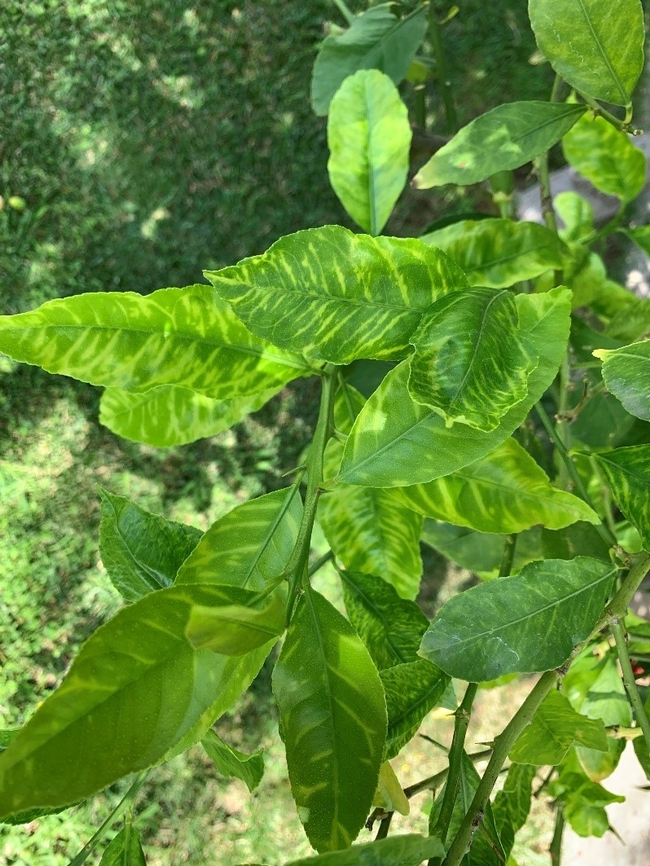The California Department of Food and Agriculture (CDFA) regularly performs surveys across the San Joaquin Valley (SJV) to monitor for potential insect and pathogen issues for California agricultural producers. In October of 2021, CDFA inspectors began performing a multi pest survey for citrus in addition to the routine inspections for the Asian citrus psyllid and Huanglongbing in residential properties. In March of 2022, a surveyor came across some unique leaf symptoms on a residential lemon tree in the city of Tulare, CA. Samples from the initial find in Tulare County were sent to CDFA's Plant Pest Diagnostic Center in Sacramento, California (https://www.cdfa.ca.gov/plant/PPD/) and tested positive for the citrus yellow vein clearing virus (CYVCV), a putative new member of the genus Mandarivirus associated with the yellow vein clearing disease of citrus. This result was subsequently confirmed by the United States Department of Agriculture, Plant Pathogen Confirmatory Diagnostics Laboratory (https://www.aphis.usda.gov/aphis/ourfocus/planthealth/ppq-program-overview/science-technology/plant-pathogen-confirmatory-diagnostics-laboratory).
After consulting with the United States Department of Agriculture regarding sampling strategies, delimitation surveys are continuing to determine the extent and distribution of CYVCV in California. Once a positive tree has been identified, CDFA returns to the property and surveys all citrus trees within a 1-mile delimitation radius around the detection, additionally CDFA conducts delimitation surveys in arcs around the delimitation core. Around the initial detection core in the city of Tulare, CDFA has already conducted 7-mile and 6-mile arcs and around the new core CDFA is conducting a 4-mile arc delimitation survey. All samples are sent to CDFA's Plant Pest Diagnostic Center for molecular testing. A total of 578 trees have tested positive so far for CYVCV in the city of Tulare and recently two trees tested positive in the city of Visalia, but no findings in commercial citrus groves in the SJV have been reported thus far.
Symptoms of CYVCV disease include vein clearing when viewed from the top of the leaves and water soaking when viewed from the bottom of the leaves. Symptomatic leaves may also be curly or have some crinkling. Researchers from other parts of the world have reported that the virus is vectored by the citrus white fly (Dialeurodes citris) and several aphid species (Aphis spiraecola, A. craccivora, and A. gossypii.), all of which occur in California. Currently scientists are performing experiments to determine vector transmission under California conditions. There have also been single reports of virus detection on some weed species and CYVCV can also spread by grafting techniques as well as by pruning tools.
The disease was first identified in Pakistan in 1988 on lemon and sour orange trees. The virus disease was then found in India on ‘Etrog' citron, ‘Rangpur' lime, sour orange, and lemon trees in India in 2003. The disease was subsequently found in Turkey, Iran, and China. Lemons and sour orange seem to be the most susceptible types to this disease, but most citrus species, varieties, and hybrids tested thus far developed the disease with varying symptomatology. Finally, there has also been one report of CYVCV infecting wild grapes in Turkey in 2020. In the study from Turkey, the infected wild grapevine was climbing on an infected citrus tree. There was no evidence of serious impacts on the wild grapevine.
It is also important to note here that the citrus yellow vein clearing virus (CYVCV) is not related to and should not be confused with the citrus yellow-vein associated virus-like RNA (CYVaV). CYVaV was recently identified to be associated with the citrus yellow-vein disease reported once in California in the 1950s in a few limequat trees, but since then, it has not been reported again in California.
The report of CYVCV from the city of Tulare, California was the first account of this virus in North America, and the impacts of this disease on the citrus economy are not clearly known at this time. Researchers in China have reported up to 80% loss in production in some lemon groves but the losses are usually less in most instances. CDFA continues with delimitation surveys around the positive finds to define the extend of the infestation and if any commercial citrus operations, groves or nurseries, are infected or are at risk. For updates on this and other citrus pests in California visit ‘Citrus Insider' at https://citrusinsider.org/.
